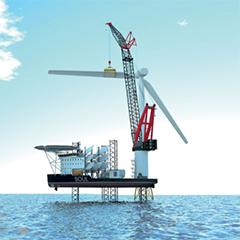We have said this before but how much lighter and more efficient can these heavy lift jack-up vessels get? PES brings you SOUL, the 4th generation of wind turbine installation vessels.
After successfully launching their revolutionary heavy lift jack-up vessel design, SOUL-partners, SeaOwls and Ulstein, continued their mission to develop the optimal range of heavy lift jack-up vessels that will enable the offshore wind industry to bring down the cost of renewable energy.
Different from the existing third generation fleet of wind turbine installation vessels (WTIVs), the SOUL heavy lift jack-up vessel design was conceived with the actual lifting operation from a stable-up platform, in mind. This design focus resulted in an unmatched heavy lift performance in terms of lifted load, reach and height for a jack-up vessel, when used for either afloat or firmly standing on its four legs.
Existing WTIVs are either ‘ships with legs’ or ‘self-propelled jack-up barges’ and both design concepts have their own strengths and weaknesses. Legged ships have limited payload and lifting capacities due to their heavy structures and narrow gaps between portside and starboard legs. Jack-up barges, with propulsion, have their own sailing and seakeeping challenges.
SOUL – the fourth generation of wind turbine installation vessels
The SOUL heavy lift jack-up vessel is a truly different design, combining all benefits from her predecessors without the associated operational compromises or shortfalls. It may be concluded that the heavy lift jack-up vessels of the SOUL-series add a fourth generation to the existing fleet of WTIVs.
The following five essential patented features distinguish every SOUL vessel from any other vessel:
1 the four legs of the up are placed in a diamond-shape pattern, with a large distance between bow, stern, portside and starboard leg
2 the vessel hull is shaped like a kite with a sharp bow and a broad transom
3 the primary load-bearing structure connects the starboard with the portside leg, and the bow leg with the stern leg in a cross-shape arrangement
4 the main crane is configured wrapped-around the stern leg with clear view on the centre of the vessel’s main deck
5 the combination of structural arrangement and hull form allows for stepless scaling of vessel dimensions
As a principle, the combination of large leg spacing, with the cruciform primary structural beam arrangement, ensures all SOUL vessels will be the lightest structures to support the most demanding heavy lift operations. This will ensure a long economic life for the vessel, as it’s always possible to add a bigger crane to handle any future, heavier and higher wind turbine components.
Other remarkable features of a SOUL jack-up vessel are the high workability for pinning the jack-up legs on site, the optimised deck logistics, a low fuel consumption thanks to undisturbed inflow to the thrusters, minimal seabed disturbance, robust and reliable jacking systems, high hook handling speeds, perfect balance without need for ballast water and a safe comfortable working environment on board the vessel.



























